Every week I talk with marketing leaders, and I’ve noticed something curious. A new common question is now about AI video. “Can we clone a voice? Can we generate scripts automatically? Can AI edit everything for us?”
But when I flip the conversation and ask, “How will this deliver ROI?”, things get quieter.
It’s not that marketers don’t care about results. In fact, they care more than ever. After years of cuts, budgets have finally rebounded going into 2026. But the message from CFOs and CEOs is crystal clear:
Bigger budgets mean stricter accountability.
That tension leaves many CMOs and senior marketers stuck between chasing AI trends and proving business impact. Some are exploring AI because it feels urgent. Others are under pressure to justify every campaign, every channel, every experiment.
Here’s the reality: not every campaign needs AI. And not every campaign should. What your team needs in 2026 is clarity. Clarity on which trends matter, which don’t, and how to make sure your strategy is grounded in outcomes, not hype.
This article brings together 10 marketing and customer engagement trends that actually matter for 2026, based on what we’ve learned at Pirsonal working with marketing, customer experience, and revenue teams around the world. Some are AI-driven. Others aren’t. But all of them tie back to one thing: making sure your message connects with the right people, in the right way, so they take action.
To get the full picture, make sure to watch the reply of our webinar about AI Personalized Video Marketing trends and ROI in 2026.
Budgets & Pressure in 2026
If you’re planning for 2026, you already know this: budgets may be rising again, but so are the expectations.
After years of cuts, Forrester analysts’ suggest marketing budgets going u in 2026. That sounds like good news, until you hear what comes next. Leadership teams aren’t satisfied with spend for the sake of spend. They want proof.
What does this mean for CMOs and senior marketing leaders?
- Bigger budgets, stricter accountability. More resources are available, but only if you can show exactly how campaigns will generate pipeline, retention, or renewals.
- The CFO is now your co-pilot. Even with increased budgets, finance leaders demand clear ROI models before sign-off. “How will this campaign pay for itself?” is now a standard question in every pitch.
- Personalization is becoming budget-critical. McKinsey reports that 76% of consumers get frustrated with brands that don’t deliver personalized experiences. The same expectation is rising in B2B. Generic videos, static PDFs, and one-size-fits-all nurture emails don’t cut it anymore.
At Pirsonal, we’ve seen this shift up close. Smart teams aren’t just asking what’s possible. They’re asking what’s profitable. One client invested $11,000 in a personalized video campaign. Within weeks, the campaign drove over $200,000 in revenue—an 18× return. That’s the kind of result CFOs notice.
The takeaway is clear: in 2026, marketing leaders will have more budget to work with, but they’ll need to prove—early and often—that every initiative ties directly to ROI. Innovation is welcome. Accountability is non-negotiable.
AI-Driven Trends for 2026
Artificial Intelligence continues to dominate marketing headlines. But here’s the truth: not every AI innovation moves the needle on ROI. Many are shiny distractions. The challenge for CMOs and senior marketing leaders is knowing which AI-driven trends are worth your time—and which will quietly drain your budget.
Here are four AI trends that will matter in 2026, with lessons we’ve learned guiding brands at Pirsonal when leveraging personalized video marketing to improve campaign performance.
AI Voiceovers & Cloning: Use Where It Truly Adds Value
AI-powered voiceovers and cloning can now replicate leadership voices or create localized audio at scale. For example, if your CEO needs to address thousands of employees worldwide, AI cloning reduces cost and turnaround time.
But here’s the caution: visuals usually drive more engagement than audio. Our experience shows that around 80% of viewers watch without sound on social media, so over-investing in personalized audio often slows projects and increases costs without proportional ROI.
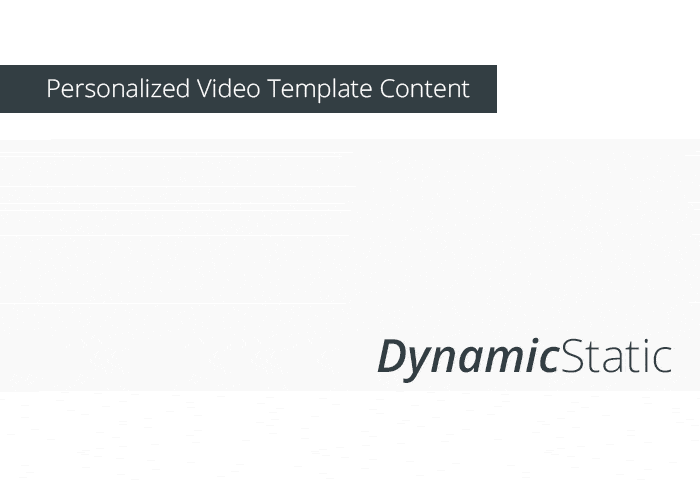
Best practice: Use AI voiceovers when audio is central to the experience (leadership updates, training content). But don’t let audio personalization become a blocker. In most marketing campaigns, contextualized visuals paired with captions are what truly drive engagement. This is how platforms like TikTok, YouTube, and LinkedIn have trained viewers.
AI Scriptwriting & Storyboarding: Context First, AI Second
One of the most common mistakes we see is teams leaning on AI tools to generate scripts with little input. The result? Generic, unconnected messages—even if personalization fields are added.
As we often tell clients: AI scripting is worthless without context. The difference between a flop and a high-performing script comes down to feeding the right signals: customer voice, personas, real data, current trends. That’s hard work, and skipping it guarantees generic results.
At Pirsonal, we blend AI efficiency with human strategy. We preload scripts with insights from ICPs, objections, and lifecycle stages. That’s why our clients’ videos often outperform movie-like ones: the content is aligned with audience context and business goals. Always on-brand.
Best practice: Use AI to accelerate scriptwriting, but layer it with ICP research and real customer data. AI should enhance, not replace, strategic copywriting.
AI Editing & Content Repurposing: Quick Wins, Real Limits
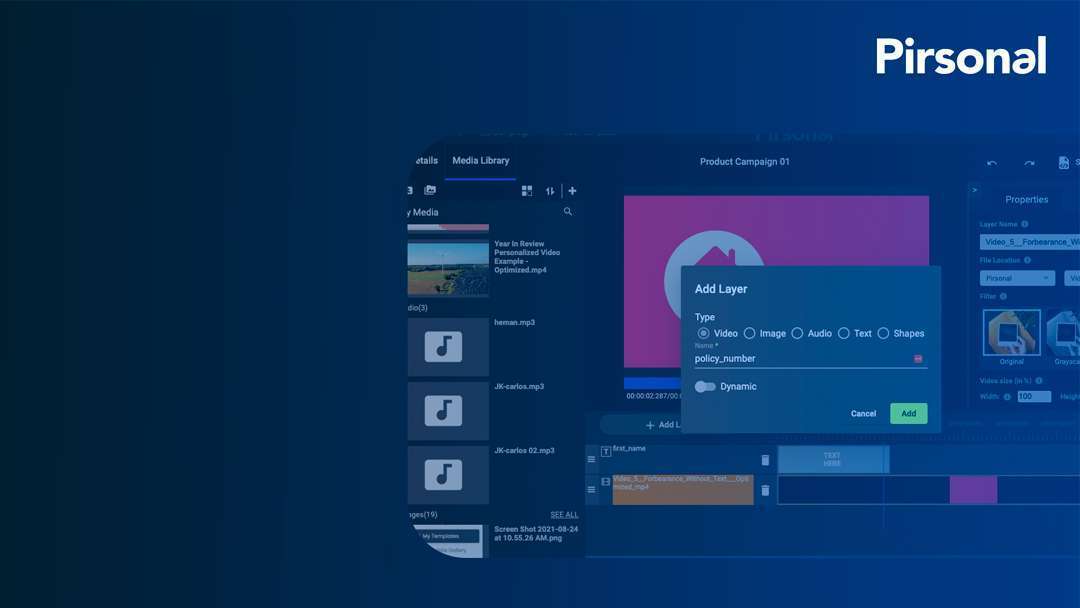
AI video editing tools can now auto-generate short video variants, swap backgrounds, or even change languages with synthetic dubbing. For lean teams, this creates speed and flexibility.
But here’s the catch: editing alone doesn’t equal engagement. If the video doesn’t speak to the viewer’s context, faster editing just means you’re publishing irrelevant content faster.
Best practice: Use AI video editing for repurposing (e.g., cutting webinars into snackable clips, localizing explainer videos). Pair it with personalization tech to adapt those clips to audience segments or individuals.
AI-Triggered Multi-Channel Workflows: Automation Meets Relevance
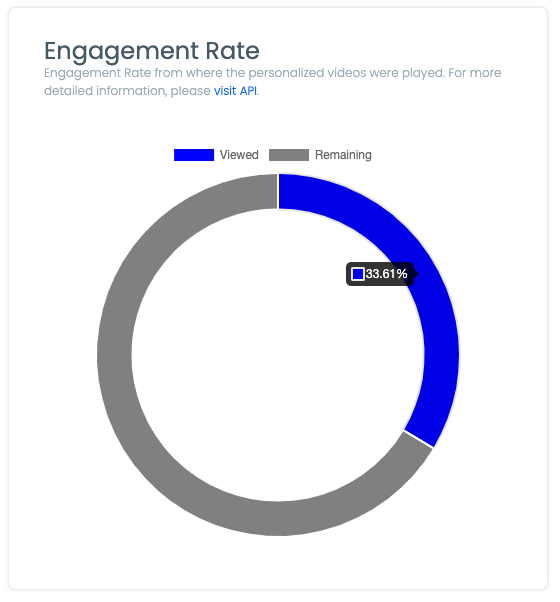
One of the most exciting frontiers is AI-driven triggers across channels. Imagine this: a customer watches 70% of a personalized video, but doesn’t click the CTA. Instantly, an SMS is triggered with a personalized link. Or an email follow-up adapts to their behavior in real time.
This is where Pirsonal’s widget and interactive video player shine—turning behavioral signals into automated next steps across email, SMS, CRM, or onboarding flows. Below you’ll find an example showing a personalized year-in-review video for Tom.
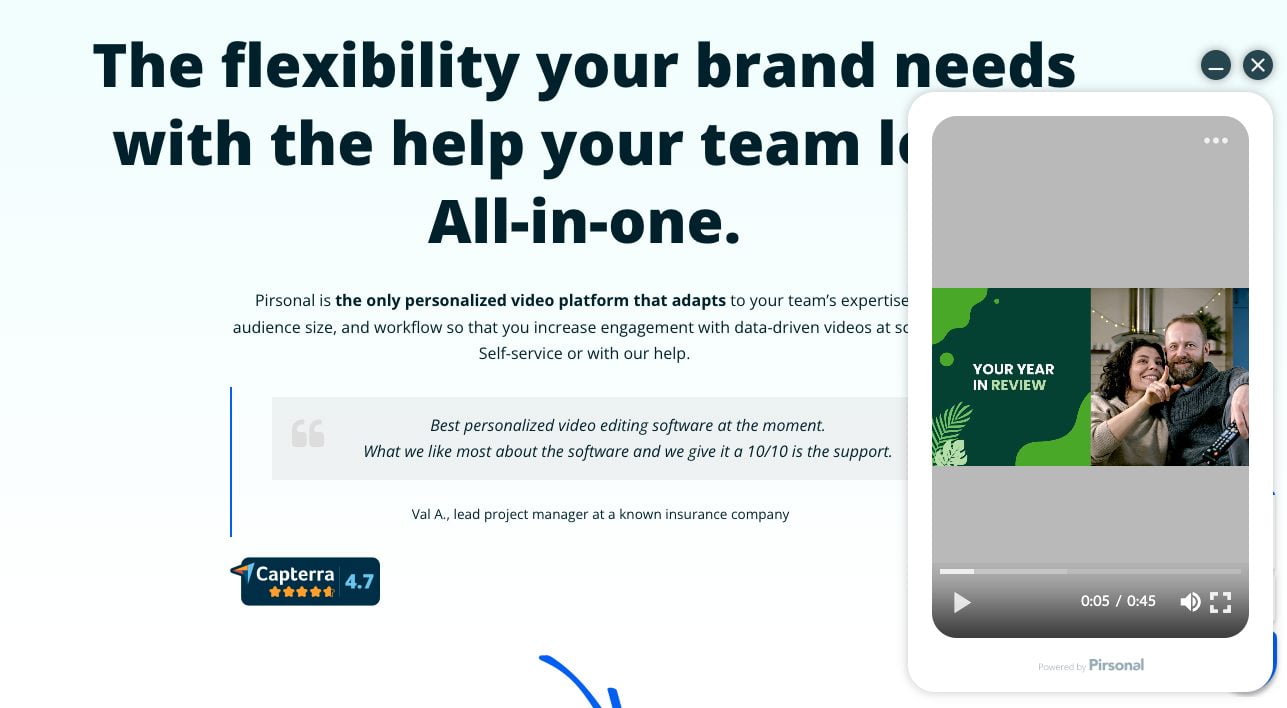
Screenshot of Personalized Video on a Website
Best practice: Don’t just automate delivery—automate the next best action. Tie AI triggers to engagement data so every touchpoint feels timely, personal, and relevant.
Together, these four AI trends reveal a pattern:
AI works best when paired with context, strategy, and personalization. The winners in 2026 won’t be the brands chasing every new AI tool. They’ll be the ones that connect AI capabilities with business goals and human insight.
Non-AI Trends That Matter in 2026
Not everything that drives marketing success in 2026 will come from AI. In fact, some of the most impactful trends are rooted in fundamentals: personalization, compliance, emotional connection, and how buying decisions are made.
Here are five non-AI trends every CMO and senior marketing leader should pay attention to.
Customer Lifecycle Personalization: Renewals, Onboarding, Loyalty
Generic touchpoints no longer move the needle. In 2026, more teams are prioritizing personalized engagement across the full lifecycle (from onboarding to renewal).
Case in point: One organization replaced their year-end PDF impact report with personalized videos created from a simple spreadsheet. The result? 64% of members watched, and 76% clicked to act. Within hours, over 100 members shared their video publicly—proving how contextual personalization turns passive reporting into loyalty-building action.
Buying Group Dynamics & CFO Involvement
The days of single-decision marketing are over. In most B2B mid-market and enterprise deals, 6–10 stakeholders influence purchase decisions. And CFOs are playing a bigger role in approving spend.
We’ve seen teams that embrace ROI transparency win approvals faster. One campaign we supported generated an 18× ROI on an $11,000 investment, leading to expansion for multiple follow-up campaigns. The math spoke louder than any demo could.
Emotional & Contextual Marketing
Attention is shrinking. Inboxes are overflowing. What makes people stop scrolling or click “play”? Emotion and context.
“Marketing should be a conversation, not a broadcast. Personalized video feels like recognition, not a campaign.”
Use case: A SaaS platform used personalized feature adoption videos to show individual users their current account state and time they could save. Adoption skyrocketed—not because the video was flashy, but because it spoke directly to each user’s situation.
Secure & Compliant Marketing
Compliance isn’t an optional trend anymore. In our experience, it’s a gating factor. In 2026, more projects are stalling in procurement or legal review if security isn’t airtight.
In our experience, many teams overlook the basics. Agencies still email CSVs, store data on laptops, or expose personal data in video URLs. These are compliance risks that stop campaigns before they start.
By contrast, Pirsonal is ISO 27001 certified, anonymizes URLs by default, and supports instant deletion and data residency options in the US or EU. This flexibility accelerates buy-in and keeps campaigns moving.
Video as the Preferred Format
Even as channels evolve, video keeps climbing as the preferred content format for B2B buyers. According to research, B2B buyers consume 13 pieces of content before making a purchase decision—and more than 70% prefer video.
“Most companies still rely on PDFs and static case studies that get ignored. Video makes complex ideas easier to understand, builds trust faster, and keeps buyers engaged longer.”
Together, these five non-AI trends show a clear direction: in 2026, the teams who win won’t just be the ones who experiment with AI. They’ll be the ones who combine lifecycle personalization, emotional relevance, compliance, and contextual video experiences into strategies that CFOs can sign off on—and customers want to share.
Hybrid & Organizational Trends in 2026
Beyond AI and compliance, the way marketing teams organize and execute campaigns is shifting fast. Two trends stand out for 2026: the rise of in-house execution and the push toward data-driven creativity.
In-House vs. Agency Execution: The Hybrid Model Wins
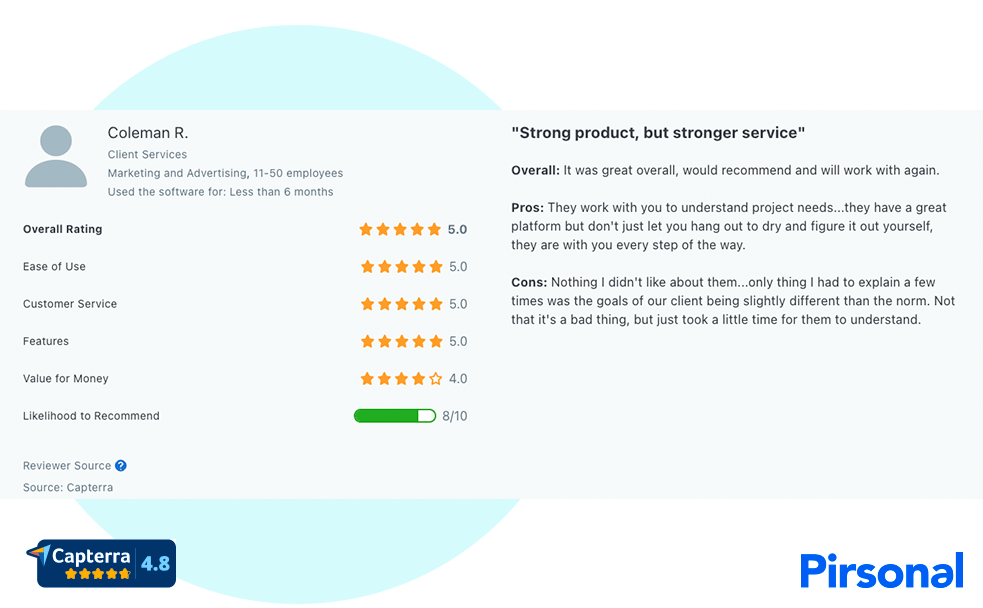
Pirsonal client testimonial
For years, personalized video campaigns were something only agencies or big in-house creative teams could handle. But in 2026, more marketing leaders are choosing hybrid models—keeping execution closer to their teams, while leaning on external experts for scale and strategy.
“Many managers face the same challenge. They have great video content, but personalizing it is a headache. They either wait for their video team, hire an agency, or put it on hold.”
This is why we built Pirsonal the way we did. Teams can create and automate personalized videos themselves, or hand us a base video and a spreadsheet, and we’ll handle the rest. For one client, this flexibility saved them weeks of delays and helped them launch in under 48 hours. For other teams, this means relying on their creative agencies for what they do best while partnering with Pirsonal for strategic video personalization paired with agency assets, technology, and compliance.
Data-Driven Creativity: When “Ugly” Beats “Polished”
It’s tempting to think that the secret to engagement is higher production value. But in our experience, context beats polish every time.
“Even so-called ugly videos can perform incredibly well when the content serves the viewer in their unique context and aligns with business goals.”
Example: A insurance firm debated investing in a polished campaign video. Instead, they launched with a simple, personalized message tied to renewal KPIs. Engagement exceeded expectations, leading to faster renewals and a measurable ROI story they could show their board.
Together, these organizational shifts point to a future where marketing leaders demand flexibility and accountability. Teams want to move faster, avoid bottlenecks, and ensure creative serves business impact. The hybrid + data-driven model makes that possible.
Frameworks & Pitfalls
Understanding the trends is one thing. Turning them into successful campaigns is another. Over the past decade, we’ve seen countless personalized video projects succeed—and a few fail. What separates the two isn’t the tool or even the creative. It’s the framework teams use to launch.
Here are three proven approaches that will help you succeed in 2026, plus the pitfalls you’ll want to avoid.
The 90-Day Roadmap: From Zero to ROI
Many teams overcomplicate their first personalized video campaign. The secret is to break it into a 90-day sprint.
- Step 1: Define clear KPIs (Weeks 1–2): Don’t start with creative. Start with goals. Is success renewals? Feature adoption? Lead conversion? Clarity here drives everything else.
- Step 2: Scope your first pilot (Weeks 3–4).Map a realistic campaign—usually 1,000–5,000 contacts, or 10–15% of your audience. Big enough to prove ROI, small enough to move fast.
- Step 3: Map your data & creative assets (Weeks 5–6). Most teams already have usable data in their CRM or a simple spreadsheet. Pair it with a base video (often from Canva, After Effects, or even your existing library).
- Step 4: Launch & measure in real time (Weeks 7–10). Use tools like Pirsonal to render videos automatically, track engagement, and trigger follow-ups.
- Step 5: Optimize & expand (Weeks 11–12).
- Review results in a monthly or quarterly meeting. Adjust CTAs, timing, or creative—and then scale.
Whether teams take the DIY lane or lean on our guided services, this roadmap consistently gets campaigns live and ROI-positive in under three months.
Understanding Your Viewers: Mr. Informed, Mr. Tell Me How, Mr. Explorer
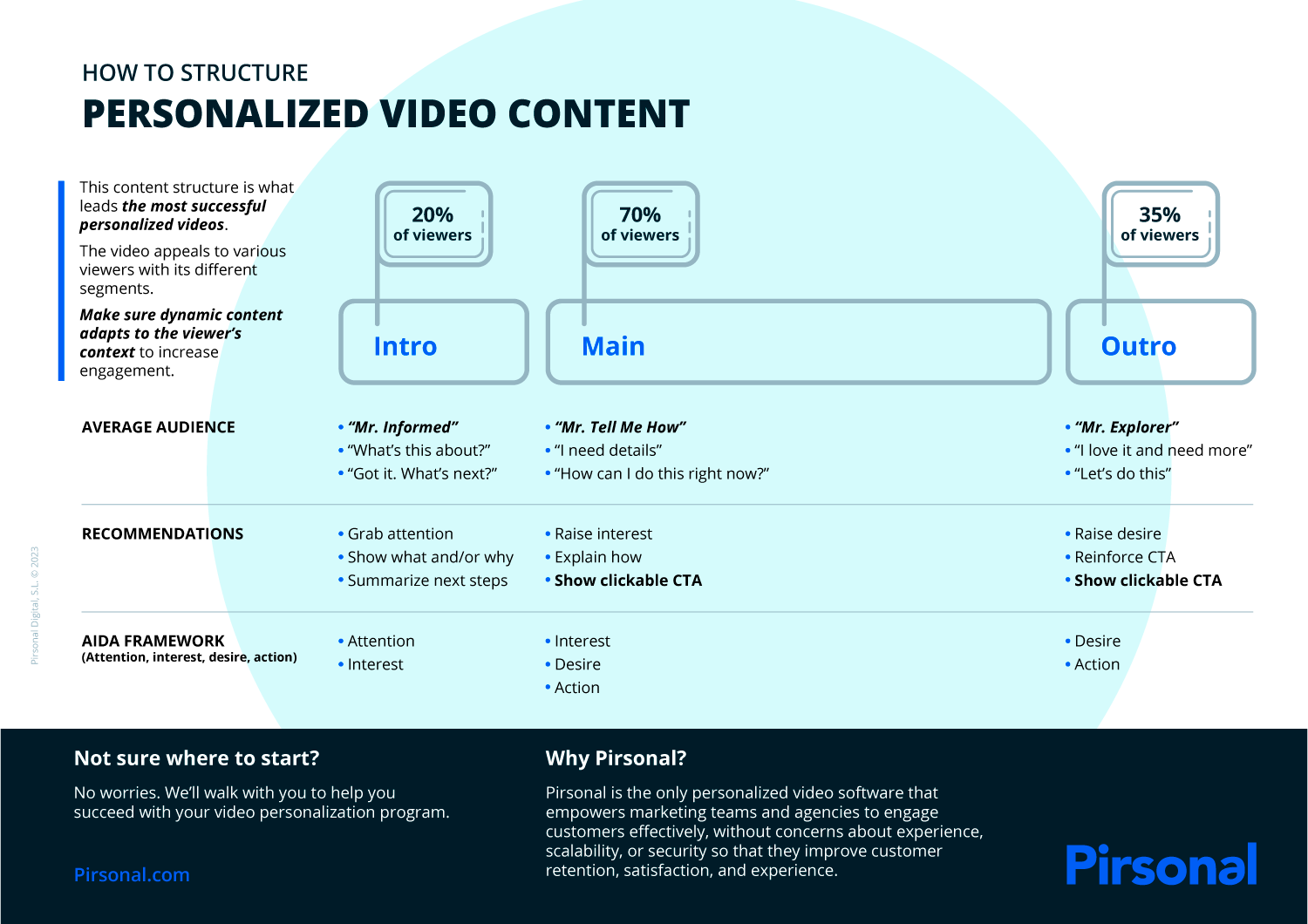
Pirsonal’s Personalized Video Content Framework
Not all viewers behave the same way. We’ve identified three common audience types in personalized video campaigns:
- Mr. Informed: Impatient. Watches only the intro. Wants the core message and CTA upfront.
- Mr. Tell Me How: Analytical. Watches the middle. Needs clear explanations and proof points before acting.
- Mr. Explorer: Engaged. Watches the full video. Curious, and ready for multiple touchpoints.
Personalized video lets you adapt every element dynamically—messaging, visuals, CTAs—to resonate with each type of viewer.
Common Pitfalls to Avoid
We’ve also seen what makes campaigns fail. Three pitfalls show up again and again:
- Starting with creative instead of goals. Beautiful videos flop if they aren’t tied to KPIs. One client initially wanted to replicate a competitor’s campaign. When we shifted focus to their real conversion goals, their “simple” video outperformed the polished ones.
- Treating personalization as a gimmick. “Hi {FirstName}” is not enough. It feels like a trick. Campaigns succeed when they adapt messaging, visuals, and CTAs to the individual’s context.
- Ignoring stakeholders. Personalized video touches marketing, creative, data, legal, even compliance. Leaving one out slows approvals and stalls launches. A 30-minute kickoff with all stakeholders saves weeks.
The most successful teams pair technology with guidance. That’s why our clients often say, “Strong product, but stronger service.”
With the right roadmap, an understanding of viewer behavior, and awareness of common pitfalls, marketing leaders can launch personalized video campaigns that drive measurable ROI—without costly detours.
Personalized Video ROI Proof: From Investment to Impact
Trends, frameworks, and creative strategies don’t matter if they don’t translate into results. Marketing leaders face one constant pressure: prove ROI.
The good news? Personalized video doesn’t just feel engaging. In our experience, it delivers measurable business impact. Here’s how.
Personalized Video to Drive Lead Conversions
One client recently invested $11,000 USD in their first personalized video campaign with us.
- Value of Each Sale: $5,000 USD per year
- Average client lifetime: 2 years. So, $10,000 per closed deal
- Campaign Results So Far: 20 new clients closed directly from the campaign
- Value = 20 × $10,000 = $200,000 USD
ROI Calculation:
ROI = (Return – Investment) ÷ Investment × 100
= ($200,000 – $11,000) ÷ $11,000 × 100
≈ 1718% ROI
That’s an 18× return on investment—from just the first campaign. And remember: they still have multiple campaigns left to run under the same budget.
Scenario Projections
To make it more tangible, let’s imagine how this plays out as they launch additional campaigns targeting different audiences.
- 40 new clients → $400,000 return → 35× ROI
- 60 new clients → $600,000 return → 53× ROI
- 100 new clients → $1,000,000 return → 89× ROI
ROI multiplies when strategy + execution are consistent across campaigns. That’s why we don’t stop at providing AI-powered personalized video software—we walk with teams through planning, execution, and optimization.
Personalized Video to Drive Retention and Loyalty
Another organization wanted to make their year-in-review impact report stand out. In the past, they sent PDFs that barely got opened. Engagement was low, and renewals lagged.
So, they switched to personalized video impact reports using the same data they already had in a spreadsheet.
Campaign Highlights:
- 1,181 members received personalized videos showing their individual contributions.
- Over 100 people shared their videos publicly within hours.
- 64% of members watched their video.
- 76% of those clicked to download or take action.
The result? Members not only understood the value they were receiving—they felt it. This boosted loyalty, renewals, and advocacy.
Personalized video isn’t just about acquisition—it also powers retention and long-term customer value.
Why ROI Happens With Personalized Video
- Relevance = More Conversions. Personalized content speaks to the individual’s context, making it far more likely to drive clicks, sign-ups, or purchases.
- Automation = Lower Costs. Once the template and workflow are set, generating thousands of videos costs less than producing even a handful of generic ones.
- Data Visibility = Faster Optimization. Campaign analytics reveal what’s working (and what’s not) in real time, so teams can pivot quickly and capture more value.
What CMOs Should Take Away
When boards or CFOs ask, “What’s the ROI of this?”—you need more than a hunch. You need hard numbers, real scenarios, and a repeatable framework. Personalized video provides exactly that when paired with strategy and not just software. Both aspects are critical.
ROI isn’t just about the video itself. It’s about how you pair technology with strategy, execution, and optimization. That’s where most teams fail—and where Pirsonal clients succeed.
Conclusion & Next Steps
Marketing and customer engagement in 2026 will be shaped by a balance of AI-driven innovation, personalized experiences, and measurable ROI. AI can speed up workflows—voice cloning, automated scripting, even predictive triggers—but not everything should be left to automation. Context, strategy, and compliance remain the real differentiators.
This is where personalized video marketing stands out. It’s not another shiny trend. It’s a proven way to:
- Cut through noise with video experiences tailored to each viewer’s data and context.
- Drive ROI with measurable engagement, conversions, and retention.
- Scale campaigns across email, CRM, onboarding, or customer success—without extra headcount.
At Pirsonal, we’ve learned that the teams that succeed are the ones who align goals + personalization + automation into a clear strategy. The teams that chase tools without clarity? They rarely see the results they want.
Ready to plan smarter for 2026?
If you want to understand where personalized video truly fits in your marketing or customer engagement strategy and how to prove ROI before budget season ends, talk with an expert at Pirsonal today You’ll leave with a clear, practical plan tailored to your goals.


